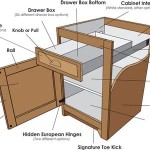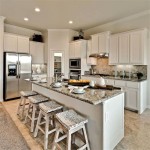Island Kitchen Cabinets: Functionality, Design, and Considerations
Kitchen islands have become a ubiquitous feature in modern home design, offering a versatile space for food preparation, dining, storage, and social interaction. A key component of many kitchen islands is the cabinet system, which provides essential storage and contributes significantly to the island's overall aesthetic. Understanding the various aspects of island kitchen cabinets is crucial for homeowners planning a kitchen renovation or new construction project.
Understanding the Purpose of Island Kitchen Cabinets
Island kitchen cabinets serve a multifaceted purpose. Primarily, they offer additional storage space in a kitchen, which can be invaluable for organizing cookware, utensils, small appliances, and pantry items. This added storage is particularly beneficial in kitchens where wall and base cabinet space is limited. Moreover, island cabinets can house specialized features, such as wine racks, pull-out drawers for spices, and designated areas for recycling bins.
Beyond storage, island cabinets contribute to the functionality of the kitchen workspace. They can be configured to accommodate built-in appliances like dishwashers, microwave ovens, or even beverage refrigerators. Incorporating a sink into the island cabinet layout allows for vegetable prepping and dishwashing activities away from the main countertop. Furthermore, the countertop surface above the cabinets provides ample space for food preparation, serving as a buffet area, or functioning as a casual dining spot.
The presence of island cabinets also plays a crucial role in defining the kitchen's layout and flow. An island can effectively separate the kitchen workspace from adjacent living or dining areas, creating a more defined and organized space. It can also serve as a central gathering point, encouraging social interaction during meal preparation or casual conversations.
Types of Island Kitchen Cabinet Configurations
The configuration of island kitchen cabinets can be tailored to meet specific needs and design preferences. A simple configuration might involve a row of standard base cabinets facing one direction, providing accessible storage for everyday items.
A more complex configuration might include a combination of different cabinet types, such as drawers, pull-outs, and open shelving. Drawers are ideal for storing utensils, cookware lids, and smaller items, while pull-outs offer convenient access to pantry items or cleaning supplies. Open shelving can be used to display decorative items or frequently used cookbooks.
Another important consideration is the cabinet depth. Standard base cabinets typically have a depth of 24 inches, but island cabinets can be deeper to provide additional countertop space or to accommodate a seating overhang. A seating overhang of at least 12 inches is recommended for comfortable seating at the island.
Cabinets on the back of the island, facing away from the main cooking area, can provide additional storage accessible from the dining or living room. These can be shallow cabinets for displaying china or storing dining linens, or deeper cabinets for storing less frequently used items.
Consider incorporating specialized cabinets catering to your cooking style. For example, if you frequently bake, a pull-out shelf designed to hold a stand mixer can be invaluable. Wine enthusiasts might opt for a built-in wine rack or a wine refrigerator within the island.
Materials and Finishes for Island Kitchen Cabinets
The choice of materials and finishes for island kitchen cabinets significantly impacts the overall aesthetic and durability of the island. Common materials include solid wood, plywood, medium-density fiberboard (MDF), and particleboard. Solid wood is a premium option that offers natural beauty and durability, but it can be more expensive than other materials. Plywood is a stable and durable option that is less prone to warping than solid wood. MDF is a smooth and consistent material that is ideal for painted finishes, while particleboard is the least expensive option but is also the least durable.
Cabinet finishes include paint, stain, laminate, and veneer. Paint offers a wide range of color options and can be applied to various materials, including wood, MDF, and particleboard. Stain enhances the natural grain of wood and provides a warm and inviting look. Laminate is a durable and easy-to-clean option that is available in a variety of colors and patterns. Veneer is a thin layer of wood that is applied over a substrate, such as plywood or MDF, to create the look of solid wood at a lower cost.
The selection of hardware, such as knobs and pulls, also contributes to the overall design. Hardware styles range from traditional to contemporary, and the finish should complement the cabinet finish and the overall kitchen design. Consider using different hardware styles on the island compared to the perimeter cabinets to make a statement or differentiate the island as a focal point. For instance, brass hardware paired with a dark-stained island can create a sophisticated contrast.
The countertop material chosen for the island is another critical factor in the overall look and functionality. Popular countertop materials include granite, quartz, marble, solid surface, and wood. Granite and quartz are durable and heat-resistant options that are available in a wide range of colors and patterns. Marble is a luxurious option that is prized for its beauty, but it is more susceptible to staining and scratching than granite or quartz. Solid surface materials are non-porous and easy to clean, making them a practical choice for busy kitchens. Wood countertops add warmth and character to the kitchen, but they require regular maintenance to prevent water damage.
Planning and Design Considerations
Careful planning is essential when designing island kitchen cabinets. The size and placement of the island should be carefully considered to ensure that it fits comfortably within the kitchen space and does not obstruct traffic flow. A minimum of 36 inches of clearance is recommended between the island and surrounding cabinets or appliances.
The height of the island should also be considered. Standard base cabinets have a height of 36 inches, but islands can be raised to bar height (42 inches) or lowered to table height (30 inches). The desired height will depend on the intended use of the island and the height of the users. A raised bar area is suitable for casual dining or entertaining, while a lowered table area is more comfortable for seated meal preparation or homework.
Electrical outlets and plumbing should be planned in advance to accommodate appliances and sinks. Electrical outlets should be strategically placed to provide power for small appliances and charging devices. Plumbing should be run to the island if a sink or dishwasher is planned.
Adequate lighting is crucial for illuminating the island workspace. Pendant lights or recessed lights can be used to provide task lighting for food preparation and dining. Consider adding under-cabinet lighting to illuminate the countertop surface and create a warm and inviting ambiance.
Finally, consider the overall style and aesthetic of the kitchen when designing island kitchen cabinets. The island should complement the other elements of the kitchen, such as the wall cabinets, flooring, and appliances. Whether the style is traditional, contemporary, or transitional, the island cabinets should be designed to create a cohesive and visually appealing space.
Installation and Maintenance
The installation of island kitchen cabinets is a complex process that typically requires professional expertise. The cabinets must be properly leveled and secured to the floor to ensure stability and prevent sagging. Electrical and plumbing connections must be made by qualified professionals to ensure safety and compliance with building codes.
Proper maintenance is essential for preserving the beauty and durability of island kitchen cabinets. Regularly clean the cabinets with a mild soap and water solution to remove dirt and grime. Avoid using abrasive cleaners or harsh chemicals, as they can damage the finish. Wipe up spills immediately to prevent staining or water damage.
Periodically inspect the cabinets for signs of damage, such as scratches, dents, or loose hardware. Repair any damage promptly to prevent further deterioration. Tighten loose screws or replace damaged hardware as needed. Consider applying a furniture polish or wax to wood cabinets to protect the finish and enhance their luster.
For painted cabinets, touch up any chips or scratches with matching paint to maintain a uniform appearance. For stained cabinets, apply a coat of clear finish every few years to protect the stain and enhance the wood's natural beauty. By following these simple maintenance tips, homeowners can ensure that their island kitchen cabinets remain beautiful and functional for years to come.

Kitchen Island Designs As Unique Your Home Cliqstudios Cabinets

White Cabinets With A Gray Kitchen Island Homecrest

Hwoamnet White Kitchen Island With Solid Wood Top Locking Wheels Storage Cabinet Drop Leaf Breakfast Bar Towel Rack Drawers Sh Wf287035wh The Home Depot

A Diy Kitchen Island Step By Guide

40 Kitchen Island Ideas To Upgrade Your Space Cabinet Kings

White Rubber Wood Desktop 53 In W Kitchen Island On 5 Wheels With Storage Cabinet And 3 Drawers Vj026kisland1 The Home Depot

7 Tips For A Better Kitchen Island Edgewood Cabinetry

Kitchen Island Does It Work With Your

5 Features To Include For The Perfect Kitchen Island

72 Large Walnut Kitchen Island With Storage Modern Cabinet Homary Ca
Related Posts








